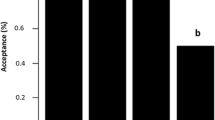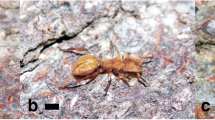Abstract
Intraspecific aggregations and colonial structures in orb-weaver spiders can reduce the per capita amount of silk to be spun, allow the use of habitats which are unavailable for solitary species, and increase protection and foraging efficiency. However, conflicts between colony members can occur during web construction, repair, and prey capture, contributing to group dissociation under conditions of low prey availability and/or in specific stages of spider maturation. While small juveniles are benefited by the joint action of many spiders during prey immobilization, older and large individuals are able to capture all available prey by themselves. For those large individuals, interactions with neighbours may compromise the amount of available resources. In this context, we evaluated the frequency of foraging events involving cooperative hunting and conflicts between residents and intruders in very young and older juveniles of Parawixia bistriata, a colonial orb-weaver spider. We recorded foraging behaviour in natural conditions and identified the main groups of insects intercepted at the webs and captured by the spiders. We then used two prey types (Lepidoptera and Orthoptera), with distinct behaviours when intercepted, in an experiment to test the influence of prey type and mass on cooperative and aggressive interactions. Most captures occurred without the participation of other individuals, and the main prey types were small Diptera and Coleoptera. Cooperative behaviour seems to occur especially between young spiderlings, but depending on prey type and size, it also occurs in late instars. The frequency of conflicts was similar in both periods of observation (November and December), with young and older individuals in colonies. Our results indicate that prey type is an important factor determining the frequency of interactions during foraging events in colonies of P. bistriata and that large spiders usually obtain success in conflicts. We suggest that these conflicts over large items may constitute a relevant variable involved in colony dissociation before spiders’ maturation.






Similar content being viewed by others
References
Alves-Costa CP, Gonzaga MO (2001) Prey capture and spatial distribution of Philoponella vittata (Araneae, Uloboridae) in host webs. Ethol Ecol Evol 3:239–246
Avilés L (1997) Causes and consequences of cooperation and permanent sociality in spiders. In: the evolution of social behavior in insects and arachnids (eds. J. Choe and B. Crespi). Cambridge University Press, Cambridge
Bertani R, Fukushima C, Martins R (2008) Sociable widow spiders? Evidence of subsociality in Latrodectus Walckenaer, 1805 (Araneae, Theridiidae). J Ethol 26:299–302
Binford G, Rypstra AL (1992) Foraging behavior of the communal spider, Philoponella republicana (Araneae: Uloboridae). J Ins Behav 5:321–335
Brown JL (1964) The evolution of diversity in avian territorial systems. Wilson Bull 76:160–169
Brown CR, Brown MB (1996) Coloniality in the cliff swallow: the effect of group size on social behavior. University of Chicago Press, Chicago
Campón FF (2007) Group foraging in the colonial spider Parawixia bistriata (Araneidae): effect of resource levels and prey size. Anim Behav 74:1551–1562
Ceballos L, Hénault Y, Legal L (2005) Foraging strategies of Eriophora edax (Araneae, Araneidae): a nocturnal orb-weaving spider. J Arachnol 33:509–515
Clark CW, Mangel M (1986) The evolutionary advantages of group foraging. Theor Populat Biol 30:45–75
Creel S, Schuette P, Christianson D (2014) Effects of predation risk on group size, vigilance, and foraging behavior in an African ungulate community. Behav Ecol 25:773–784
Diaz C, Tanikawa A, Miyashita T, Amarpuri G, Jain D, Dhinojwala A, Blackledge TA (2018) Supersaturation with water explains the unusual adhesion of aggregate glue in the webs of the moth-specialist spider, Cyrtarachne akirai. R Soc Open Sci 5:181296 https://doi.org/10.1098/rsos.181296
Dubois F, Giraldeau L-A (2003) The forager’s dilemma: food sharing and food defense as risk-sensitive foraging options. Am Natur 162:768–779
Dubois F, Giraldeau L-A, Grant JWA (2003) Resource defense in a group-foraging context. Behav Ecol 14:2–9
Endo T (1989) How to avoid becoming a prey: predatory encounters between an orb-weaving spider, Araneus pinguis (Karsch) (Araneae: Araneidae) and flying insects. Ecol Res 4:361–371
Fowler HG, Gobbi N (1988a) Communication and synchronized molting in a colonial araneid spider, Eriophora bistriata. Experientia 44:720–722
Fowler HG, Gobbi N (1988b) Cooperative prey capture by an orb-web spider. Naturwissenschaften 75:208–209
Gan W, Liu S, Yang X, Li D, Lei C (2015) Prey interception drives web invasion and spider size determines successful web takeover in nocturnal orb-web spiders. Biol Open 4:326–1329
Gazda SK, Connor RC, Edgar RK, Cox F (2005) A division of labour with role specialization in group-hunting bottlenose dolphins (Tursiops truncatus) off Cedar Key, Florida. Proc Royal Soc B 272:135–140
Goldberg JL, Grant JWA, Lefebvre L (2001) Effects of the temporal predictability and spatial clumping of food on the intensity of competitive aggression in the Zenaida dove. Behav Ecol 12:490–495
Grant JWA (1993) Whether or not to defend? The influence of resource distribution. Mar Behav Physiol 23:137–153
Guevara J, Gonzaga MO, Vasconcellos-Neto J, Avilés L (2011) Sociality and resource use: insights from a community of social spiders in Brazil. Behav Ecol 22:630–638
Guindre-Parker S, Rubenstein R (2018) Multiple benefits of alloparental care in a flutuating environment. R Soc Open Sci 5:172406
Hodge MA, Uetz GW (1995) A comparison of agonistic behaviour of colonial web-building spiders from desert and tropical habitats. Anim Behav 50:963–972
Hoffman CR, Avilés L (2017) Rain, predators, and spider sociality: a manipulative experiment. Behav Ecol 28:589–596
Ibarra-Nuñez G, García JA, López JA, Lachaud JP (2001) Prey analysis in the diet of some ponerine ants (Hymenoptera: Formicidae) and web-building spiders (Araneae) in coffee plantations in Chiapas, Mexico. Sociobiology 37:723–756
Krause J, Ruxton GD (2002) Living in groups. Oxford University Press, Oxford
Levi HW (1992) Spiders of the orb-weaver genus Parawixia in America (Araneae: Araneidae). Bull Mus Comp Zool 153:1–46
Lloyd NJ, Elgar M (1997) Costs and benefits of facultative aggregating behaviour in the orb-spinning spider Gasteracantha minax Thorell (Araneae: Araneidae). Austral Ecol 22:256–261
Lubin YD (1974) Adaptive advantages and the evolution of colony formation in Cyrtophora (Araneae: Araneidae). Zool J Linnean Soc 54:321–339
Majolo B, Vizioli AB, Schino G (2008) Costs and benefits of group living in primates: group size effects on behaviour and demography. Anim Behav 76:1235–1247
Masumoto T (1998) Cooperative prey capture in the communal web spider, Philoponella raffrayi (Araneae, Uloboridae). J Arachnol 26:392–396
McReynolds CN (2000) The impact of habitat features on web features and prey capture of Argiope aurantia (Araneae, Araneidae). J Arachnol 28:169–179
McReynolds CN, Polis GA (1987) Ecomorphological factors influencing prey use by two sympatric species of orb-web spiders, Argiope aurantia and Argiope trifasciata (Araneidae). J Arachnol 15:371–383
Murakami Y (1983) Factors determining the prey size of the orb-web spider, Argiope amoena (L. Koch) (Argiopidae). Oecologia 57:72–77
Nentwig W (1982) Why do only certain insects escape from a spider’s web? Oecologia 53:412–417
Packer C, Ruttan L (1988) The evolution of cooperative hunting. Am Natur 132:159–198
Paiva LV, Araújo GM, Pedroni F (2007) Structure and dynamics of a woody plant community of a tropical semi-deciduous seasonal forest in the “Estação Ecológica do Panga”, municipality of Uberlândia, Minas Gerais, Brazil. Rev Bras Bot 30:365–373
Pekár S, Hrušková M, Lubin Y (2005) Can solitary spiders (Araneae) cooperate in prey capture? J Anim Ecol 74:63–70
Pekár S, Coddington JA, Blackledge TA (2011) Evolution of stenophagy in spiders (Araneae): evidence based on the comparative analysis of spider diets. Evolution 66:776–806
R Development Core Team (2016) R: a language and environment for statistical computing. R Foundation for Statistical Computing, Vienna (Austria) Available from: http://www.R-project.org/
Rayor LS, Uetz GW (1990) Trade-offs in foraging success and predation risk with spatial position in colonial spiders. Behav Ecol Sociobiol 27:77–85
Rayor LS, Uetz GW (2000) Age-related sequential web building in the colonial spider Metepeira incrassata (Araneidae): an adaptive spacing strategy. Anim Behav 59:1251-12-59
Sandoval CP (1987) Aspectos da ecologia e socialidade de uma aranha colônia, Eriophora bistriata (Rengger, 1936) (Araneidae). Universidade Estadual de Campinas, Dissertation
Schuck-Paim C (1999) Ecologia comportamental de Nephilengys cruentata (Araneae, Tetragnathidae): uso do espaço. Universidade de São Paulo, Dissertation
Souza ALT, Gonzaga MO, Vasconcellos-Neto J (2007) Prey capture behaviour in the social spider Anelosimus eximius (Araneae: Theridiidae): responses to prey size and type. Ethol 113:856–861
Trabalon M, Bagnères AG, Hartmann N, Vallet AM (1996) Change in cuticular compounds composition during the gregarious period and after dispersal of the young in Tegenaria atrica (Araneae, Agelenidae). Insect Biochem Mol Biol 26:77–84
Trabalon M (2013) Chemical communication and contact cuticular compounds in spiders. In: Spider Ecophysiology (ed. W. Nentwig). Springer, Berlin
Uetz GW (1989) The ricochet effect and prey capture in colonial spiders. Oecologia 81:154–159
Uetz GW, Hieber CS (1994) Group size and predation risk in colonial web-building spiders: analysis of attack abatement mechanisms. Behav Ecol 5:326–333
Uetz GW, Boyle J, Hieber CS, Wilcox RS (2002) Anti-predator benefits of group living in colonial web-building spiders the “early warning” effect. Anim Behav 63:445–452
Ward A, Webster M (2016) Sociality: the behaviour of group-living animals. Springer, Cham
Ward PI, Enders MM (1985) Conflict and cooperation in the group feeding of the social spider Stegodyphus mimosarum. Behaviour 94:167–182
Wenseleers T, Bacon JP, Alves DA, Couvillon MJ, Kärcher M, Nascimento FS, Nogueira-Neto P, Ribeiro M, Robinson EJH, Tofilski A, Ratnieks FLW (2013) Bourgeois behavior and freeloading in the colonial orb web spider Parawixia bistriata (Araneae, Araneidae). Am Nat 182:120–129
Wise DH (1983) Competitive mechanisms in a food-limited species: relative importance of interference and exploitative interactions among labyrinth spiders (Araneae: Araneidae). Oecologia 58:1–9
Wise DH, Barata JL (1983) Prey of two syntopic spiders with diferent web structures. J Arachnol 11:271–281
World Spider Catalog (2019) Version 19.5. Natural History Museum Bern. http://wsc.nmbe.ch. Accessed 26 May 2019
Yip EC, Levy T, Lubin Y (2017) Bad neighbors: hunger and dominance drive spacing and position in an orb-weaving spider colony. Behav Ecol Sociobiol 71:128. https://doi.org/10.1007/s00265-017-2357-6
Zöttl M, Frommen JG, Taborsky M (2013) Group size adjustment to ecological demand in a cooperative breeder. Proc R Soc B 280:20122772
Funding
This project was supported by Duratex S.A., Programa de Pós-Graduação em Ecologia e Conservação de Recursos Naturais, Universidade Federal de Uberlândia (UFU), Coordenação de Aperfeiçoamento de Pessoal de Nível Superior (CAPES) - Finance Code 001, Instituto Nacional de Ciência e Tecnologia dos Hymenoptera Parasitoides da Região Sudeste (HYMPAR/Sudeste - CNPq/CAPES/Fapesp), Fundação de Amparo à Pesquisa do Estado de Minas Gerais (Proc. APQ-02104-14, CRA-30058/12, APQ-03202-13; APQ-02474-15), and Conselho Nacional de Desenvolvimento Científico e Tecnológico (Proc. 311823/2017-3; 403733/2012-0; 445832/2014-2; 465562/2014-0; 441225/2016-0). Camila Vieira was funded by Coordenação de Aperfeiçoamento de Pessoal de Nível Superior (CAPES) Proc. 88882.314749/2019-01.
Author information
Authors and Affiliations
Corresponding author
Additional information
Publisher’s note
Springer Nature remains neutral with regard to jurisdictional claims in published maps and institutional affiliations.
Electronic supplementary material
Rights and permissions
About this article
Cite this article
Quero, A., Zuanon, L.A., Vieira, C. et al. Cooperation and conflicts during prey capture in colonies of the colonial spider Parawixia bistriata (Araneae: Araneidae). acta ethol 23, 79–87 (2020). https://doi.org/10.1007/s10211-020-00342-x
Received:
Revised:
Accepted:
Published:
Issue Date:
DOI: https://doi.org/10.1007/s10211-020-00342-x




